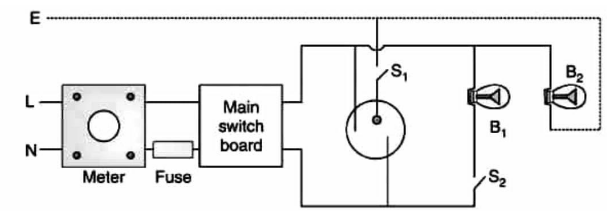
Describe a domestic electric circuit with the help of a diagram.
Answer
510.6k+ views
Hint:Electric circuit wringing in houses and structures is known as domestic circuit wringing. A pair of insulated copper or aluminium wires transport electricity to our homes. A red colour wire (known as the live wire, L) and a black colour wire make up this pair (called neutral wire, N).
Complete answer:
The electric system in a typical home is very basic. There are three kinds of wire in this set:
1. Earthing (green wire)
2. Live (Red wire)
3. Ambient (Black Wire)
Electricity is produced in power plants, and it is transported to our homes through extremely thick wires strung between electric poles. Then it spreads in our home. The following is a diagram of the circuit that shows how it hits every corner:

Live wire and neutral wire: These are the key wires, or the positive and negative terminals of the circuit, as their name implies (respectively). The voltage difference between these two wires is $220V$ and the alternating current given by these wires has a frequency of $50\,Hertz$ .
These wires from the electric boards fuse pass through the house's electricity metre before being connected to the main switch. All of the appliances are connected in parallel to the main switch from there. The aim of a parallel link is to ensure that each plug/device receives the same voltage.
Earthing wire: It's a precautionary measure to avoid electric shocks and system harm. Electric motors, heaters, irons, and refrigerators all use a lot of current. So there is a leak of electricity/current from these machines from time to time, which can cause serious harm to everyone.
Note:Since parallel circuits ensure that all components in the circuit have the same voltage as the source, they are often used in domestic wiring to link lights and other electrical equipment. In a parallel circuit, adding more components does not increase resistance. A parallel circuit's resistance can be further reduced by introducing further pathways.
Complete answer:
The electric system in a typical home is very basic. There are three kinds of wire in this set:
1. Earthing (green wire)
2. Live (Red wire)
3. Ambient (Black Wire)
Electricity is produced in power plants, and it is transported to our homes through extremely thick wires strung between electric poles. Then it spreads in our home. The following is a diagram of the circuit that shows how it hits every corner:

Live wire and neutral wire: These are the key wires, or the positive and negative terminals of the circuit, as their name implies (respectively). The voltage difference between these two wires is $220V$ and the alternating current given by these wires has a frequency of $50\,Hertz$ .
These wires from the electric boards fuse pass through the house's electricity metre before being connected to the main switch. All of the appliances are connected in parallel to the main switch from there. The aim of a parallel link is to ensure that each plug/device receives the same voltage.
Earthing wire: It's a precautionary measure to avoid electric shocks and system harm. Electric motors, heaters, irons, and refrigerators all use a lot of current. So there is a leak of electricity/current from these machines from time to time, which can cause serious harm to everyone.
Note:Since parallel circuits ensure that all components in the circuit have the same voltage as the source, they are often used in domestic wiring to link lights and other electrical equipment. In a parallel circuit, adding more components does not increase resistance. A parallel circuit's resistance can be further reduced by introducing further pathways.
Recently Updated Pages
Two men on either side of the cliff 90m height observe class 10 maths CBSE

Cutting of the Chinese melon means A The business and class 10 social science CBSE

Show an aquatic food chain using the following organisms class 10 biology CBSE

How is gypsum formed class 10 chemistry CBSE

If the line 3x + 4y 24 0 intersects the xaxis at t-class-10-maths-CBSE

Sugar present in DNA is A Heptose B Hexone C Tetrose class 10 biology CBSE

Trending doubts
Why is there a time difference of about 5 hours between class 10 social science CBSE

What is the median of the first 10 natural numbers class 10 maths CBSE

Write a letter to the principal requesting him to grant class 10 english CBSE

The Equation xxx + 2 is Satisfied when x is Equal to Class 10 Maths

Discuss the main reasons for poverty in India

What are luminous and Non luminous objects class 10 physics CBSE




